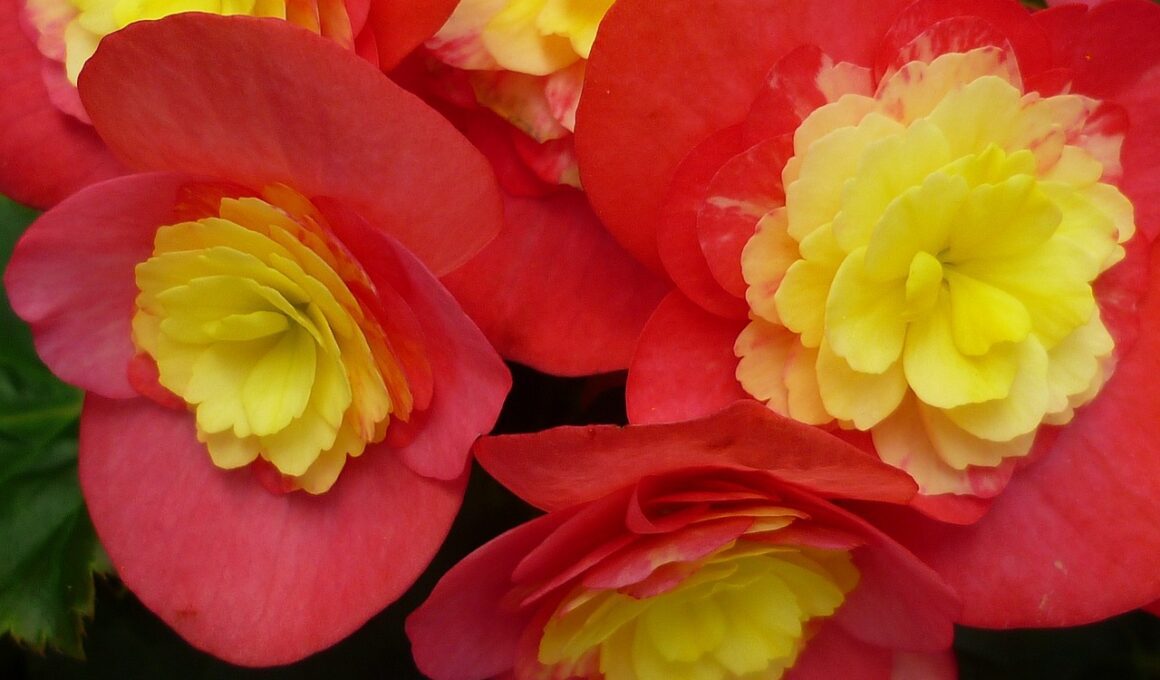Are you a fan of begonias? These beautiful plants come in a variety of colors and sizes, and they’re perfect for adding some color to your home or garden. However, if you live in a colder climate, you might be wondering which begonias go dormant in winter.
Understanding begonia dormancy is important if you want to keep your plants healthy and thriving. In this article, we’ll explore the different types of begonias and how to care for them during the winter months.
As temperatures drop, many plants go into a state of dormancy to conserve energy and protect themselves from the cold. Begonias are no exception, and some varieties will naturally go dormant during the winter. However, not all begonias will do this, so it’s important to know which types you have.
By understanding the needs of your plants, you can provide the right care to keep them healthy and thriving all year round. So, let’s dive into the world of begonias and learn more about which ones go dormant in winter.
Understanding Begonia Dormancy
Get ready for the natural cycle of rest and rejuvenation as begonias enter their dormancy period during the winter months. This is a natural process that happens to most plants as a result of seasonal changes.
Begonia winterization is important to maintain the health and longevity of your plants. During the winter, begonias will slow down their growth and conserve energy, which means they will require less water and fertilizer. It’s important to reduce watering and fertilization during this time to prevent overwatering and over-fertilization.
Keep an eye on the soil moisture and only water when the top inch of soil feels dry. While some begonia varieties may go completely dormant and lose all their leaves, others may only partially go dormant and keep some of their leaves. This is a natural process and should not be a cause for concern.
Remember to keep your begonias in a cool, dry location during the winter months to encourage dormancy and ensure they come back stronger and healthier in the spring.
Care for Dormant Begonias
During the colder months, it’s important to give your begonias a break and allow them to rest until spring arrives. This is the time when your begonias go dormant, which means they stop growing and conserve their energy.
But what should you do to take care of your dormant begonias? Here are a few tips to help you out:
-
Storing tubers: If your begonias are tuberous, make sure to dig them up and store them in a cool, dry place for the winter. This will prevent them from rotting and ensure they’re ready to be replanted in the spring.
-
Watering frequency: You’ll want to water your dormant begonias less frequently than during the growing season. Only water them when the soil is completely dry to the touch. Overwatering can lead to root rot, while underwatering can cause the tubers to dry out and die.
-
Keep them in a cool, dry place: Begonias prefer cooler temperatures during their dormancy period. Keep them in a location where the temperature stays between 50-60 degrees Fahrenheit. A basement or garage can be a good option, as long as the area is dry and well-ventilated.
-
Don’t disturb them: During dormancy, begonias are very sensitive to disturbance. Avoid moving them around or repotting them unless absolutely necessary. Let them rest and conserve their energy until it’s time for them to wake up in the spring.
By following these tips, you can help ensure your dormant begonias stay healthy and ready to grow when the warmer weather arrives. Remember to be patient and let your begonias rest during the winter – they’ll thank you for it in the long run!
What Steps Should I Take to Prepare Dormant Begonias for Winter Storage?
To prepare begonias for winter storage, follow these steps. First, gently brush off any dirt from the plants and remove dead leaves or flowers. Next, cut back the stems to about 6 inches. Then, carefully dig up the tubers and let them dry for a few days. Finally, place the tubers in a box filled with peat moss or vermiculite, and store them in a cool, dark place until spring.
Care for Non-Dormant Begonias
If you have non-dormant begonias, you need to keep them indoors. These plants are sensitive to temperature changes and can’t handle the cold.
Adjust their light conditions to make sure they get enough sunlight but not too much. Also, maintain adequate humidity levels to prevent their leaves from drying out.
Keep Them Indoors
You’ll love keeping your begonias indoors during the winter months. Not only will you be able to enjoy their vibrant colors all year round, but you’ll also be able to protect them from the harsh winter weather.
Here are some tips to help you keep your begonias healthy and happy indoors:
-
Find a bright spot in your home where your begonias can get plenty of sunlight. A south-facing window is ideal, but if that’s not possible, you can use artificial grow lights to supplement natural light.
-
Water your begonias only when the soil feels dry to the touch. Overwatering can lead to root rot, which can be fatal for your plants. Remember that your begonias will need less water during the winter months because they won’t be growing as actively as they do in the summer.
-
Keep the temperature in your home between 60 and 70 degrees Fahrenheit. Begonias prefer a slightly cooler environment, but they can’t tolerate temperatures below 50 degrees Fahrenheit. Avoid placing your plants near drafty windows or doors, as this can cause temperature fluctuations that can stress your begonias.
By following these simple tips, you can keep your begonias healthy and beautiful all year round. Just remember to provide them with the right amount of light, water, and temperature, and you’ll have happy begonias that will thrive in your home.
Adjust Light Conditions
Make your begonias truly shine by adjusting their light conditions during the winter months to keep them healthy and thriving.
When it comes to lighting options for your indoor begonias, make sure they receive bright, indirect light to keep them happy. If your home doesn’t receive enough natural light, consider using artificial grow lights to give them the light they need.
During winter storage, it’s important to keep in mind that most begonias go dormant, meaning they require less light to survive. However, it’s still important to provide them with some light to prevent them from completely drying out.
A bright, cool spot with a few hours of indirect light each day is perfect for your dormant begonias.
By adjusting their light conditions, you can keep your begonias healthy and happy all year round.
Maintain Adequate Humidity
To keep your indoor begonias thriving, humidity control is key. Begonias are native to tropical regions and require high levels of humidity to grow properly. You can maintain adequate humidity by placing a tray of water near the plants and misting them regularly. You can also use a humidifier to keep the air moist.
Here are a few watering tips to keep in mind when caring for your dormant begonias:
-
Water your begonias sparingly during their dormant period, as they don’t require as much water as they do during their active growing period.
-
Ensure that the soil is well-draining, as begonias don’t like to sit in water for extended periods of time.
-
Use room-temperature water when watering your begonias, as cold water can shock the roots and cause damage to the plant.
By following these tips, you can help your dormant begonias survive the winter and thrive once spring arrives.
Identifying Your Begonia Variety
If you’re unsure about the type of begonia you have, identifying the variety can provide helpful information for its care and maintenance. Some begonias are grown for their foliage, while others are grown for their showy flowers. Once you know what kind of begonia you have, it’ll be easier to determine its specific needs.
There are dozens of begonia varieties, but some of the most common types include cane, angel wing, rhizomatous, and tuberous. Cane begonias are tall and bushy, with bamboo-like stems. Angel wing begonias have large, wing-shaped leaves and produce clusters of drooping flowers. Rhizomatous begonias have thick, fleshy stems and grow low to the ground. Tuberous begonias produce large, colorful flowers and go dormant in the winter.
Identifying your begonia can help you determine its soil requirements and propagation methods. Some begonias prefer well-draining soil, while others need a soil that retains moisture. Some begonias can be propagated by leaf cuttings, while others require stem cuttings.
Knowing what kind of begonia you have will ensure that you’re providing it with the best possible care.
Can the same methods used to keep sage alive in the winter be applied to begonias that go dormant?
Yes, the same methods used for keeping sage alive in winter can be applied to begonias that go dormant. Both plants benefit from being brought indoors to a sunny window, watering sparingly, and protecting them from frost. Mulching can also help insulate the roots and keep them from drying out.
Best Practices for Begonia Care
For optimal growth and maintenance, it’s important to follow these best practices when caring for your begonia.
First, make sure to water your begonia regularly but avoid overwatering as this can lead to root rot. Allow the soil to dry out slightly between waterings.
Second, begonias prefer bright, indirect light. Place your begonia near a window that receives morning or evening sun but avoid direct sunlight as it can scorch the leaves.
Third, be sure to fertilize your begonia regularly with a balanced fertilizer to promote healthy growth.
When it comes to begonia propagation, there are a few different methods you can try. You can propagate begonias from stem cuttings or leaf cuttings. Place the cuttings in soil and keep them moist until new growth appears. Alternatively, you can propagate begonias through division. Gently remove the plant from its pot and separate the roots into smaller sections, then plant each section in its own pot.
Finally, soil requirements are important when it comes to begonia care. Begonias prefer well-draining soil that is rich in organic matter. A mix of peat moss, perlite, and vermiculite is a good option for begonias. Avoid using heavy soils that do not drain well as these can lead to root rot.
With these best practices in mind, you can keep your begonia healthy and thriving year-round.
Frequently Asked Questions
What is the best temperature for dormant begonias?
To ensure that your dormant begonias survive the winter, it’s important to prepare them properly. One key factor is maintaining an optimal temperature.
Generally, begonias prefer temperatures between 60-70°F, but during dormancy, they can tolerate cooler temperatures around 50°F. It’s important to avoid extreme temperature fluctuations, as this can damage the plant.
To prepare for winter, gradually reduce watering and fertilization as the plant begins to slow down. Once the leaves have fallen off, move the plant to a cool, dark location with good air circulation.
With the right winter preparation and optimal temperature, your begonias will be ready to thrive come springtime.
How often should non-dormant begonias be watered?
To keep your non-dormant begonias healthy, it’s important to monitor their watering frequency and soil moisture.
These plants prefer consistently moist soil, but too much water can lead to root rot. A good rule of thumb is to water your begonias when the top inch of soil feels dry to the touch.
During the summer months, you may need to water your plants more frequently, while in the winter, you can reduce watering frequency. It’s important to pay attention to your plant’s individual needs and adjust watering accordingly.
By maintaining proper soil moisture, you’ll ensure that your begonias thrive and continue to brighten up your space.
Can all begonia varieties go dormant in the winter?
If you’re wondering whether all begonia varieties can go dormant in the winter, the answer is yes! Most of them can go dormant during the winter months. This is an important process for begonias because it allows them to conserve energy and prepare for the next growing season.
During dormancy, begonias will stop growing, their leaves will fall off, and they will rest until the weather warms up again. So, if you have a begonia plant at home, don’t worry about its winter survival. Just make sure to provide the right conditions for dormancy, such as reduced watering, lower temperatures, and less light.
Are there any types of begonias that should not be allowed to go dormant?
When it comes to begonias, there are some types that you should avoid allowing to go dormant in the winter. The Rex begonia, for example, can be prone to rotting if left in cold, damp conditions for too long.
To keep your plants healthy, it’s important to use careful propagation techniques when starting new plants. Additionally, you should watch out for common diseases like powdery mildew and bacterial leaf spot.
By taking these steps, you can help ensure that your begonias stay healthy and happy year-round.
What is the most common mistake people make when caring for begonias?
When it comes to caring for begonias, there are common mistakes that people often make. One of the most common mistakes is not providing proper care. This can include overwatering or underwatering, not providing enough sunlight, or not fertilizing the plant properly.
It’s important to do your research and understand the specific needs of the type of begonia you have. Proper care can help prevent issues like yellowing leaves or wilting. By taking the time to give your begonia the care it needs, you can help ensure its health and longevity.
Conclusion
In conclusion, taking care of your begonias during winter dormancy is vital to ensure they stay healthy and thrive when they come out of dormancy. Remember to reduce watering, provide adequate lighting, and store them in a cool, dry location.
It’s also crucial to identify your begonia variety to determine if it goes dormant or not. By following the proper care instructions, you can ensure your begonias will come back even more beautiful and vibrant in the spring.
With a little bit of effort and attention, you can enjoy these stunning plants year after year.









